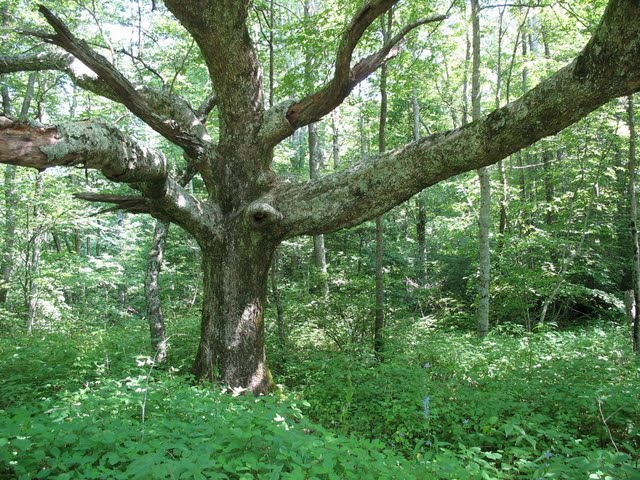Ents,
Last month, I spent a few days hiking in the Cohutta
Wilderness Area
after having been away from the area for four years. On this
return
trip, I was repeatedly struck by the Cohutta's unusual species
distributions and the odd juxtapositions allowed by the area's
location and topography. Elevations in the wilderness area
range from
just under a thousand feet near the mouth of the Jacks River to
4151'
on Cowpen Mountain, and the range comprises the western edge of
the
Appalachians, except for smaller foothills that continue into
Alabama
(I wrote a fuller overview of the Cohuttas here
http://tinyurl.com/ml7lcq). Loblolly pine, among the most
ubiquitous
trees in the Piedmont of the Southeast but absent elsewhere in
the
Appalachians, follows larger streams into the Cohuttas and
scattered
individuals reach as high as 2200' elevation. They compete
directly
with hemlock, white pine, and sweetgum. White pine’s range
overlaps
with loblolly only in the cohuttas and surrounding areas, so
those two
workhorses of the timber industry rarely interact. Sweetgum,
similar
to loblolly pine in general distribution although creeping into
the
edges of several other mountain ranges, remains a dominant
stream side
tree to over 2000'. The phenomenon occurs not only in trees,
but also
shrubs. Yellowroot, a small riparian shrub common in the
Piedmont,
occurs in patches as high as 2800’. Adding to the unusual
combinations, scattered yellow birch, a tree in Georgia
generally
restricted to high peaks, grow along the Conasauga River down to
at
least 2000’.
When I saw some saplings with extremely large leaves growing
along the
road at the wilderness area’s southern edge, I thought umbrella
magnolia, a tree of low elevation mountain streams that occurs
in the
eastern half of the wilderness area, also reached exceptional
elevations . On closer inspection, the saplings turned out to
be big
leaf magnolia, a similar species whose closest natural
populations are
30 or 40 miles to the south. Either birds have carried the seed
from
yard trees a few miles away, or someone has chosen convenient
canopy
gaps to try to start a new population. In either case, the
trees seem
unlikely to survive long since they grow on the shoulders of a
high,
exposed ridge rather than the species’ typical habitat of narrow
ravines.
On the trip, my dad and I also explored several coves for
tall trees.
As occurs elsewhere in the wilderness area with remarkable
consistency, tuliptrees shaded a dense herb layer at upper ends
of
north facing coves, but at about the point where surface water
began
to flow the understory changed to pure rhododendron and hemlocks
entered the canopy. A well sheltered east facing cove with
slightly
older forests than previously visited local rich coves followed
that
pattern, and held easily the most impressive trees. In addition
to
tuliptrees, scattered basswood, bitternut hickory, and sugar
maples
reached the overstory, and sapling silverbell, buckeye, and
sugar
formed a well developed midstory. Unfortunately, by the time I
reached the cove, I barely had enough light to see through the
rangefinder, so I could only collect rough heights only a few
trees.
Species…………….……Cbh……Height
Hemlock………………...NA…….138.9’
Hemlock*………………..NA…….149.0’
Magnolia, Cucumber……8’0”…...129.1’
Maple, Sugar*…………...9’4”……121.2’
Oak, Northern Red……...8’8.5”….132.4’
Pine, White……………...NA……..145.1’
Tuliptree*………………...9’1”…….150.4’
Winterberry, Mountain…1’1”…….34.7’
Winterberry, Mountain…1’9”…….38.1’
*tree in the cove described above
The hemlock and northern red oak are each the fifth tallest
of the
species measured in Georgia with all of the taller red oaks
growing in
the Chattooga/Tugaloo watershed. The cucumbertree is the second
tallest known in Georgia, and sugar maple and mountain
winterberry are
Georgia's tallest known individuals.
Rucker Index…………..134.8’
Tuliptree………………..150.4’
Hemlock………………..149.0’
White Pine……………..145.1’
Pignut Hickory………...140.3’
Black Cherry…………..137.3’
Northern Red Oak……..132.4’
Cucumber Magnolia…..129.1’
White Ash……………...128.0’
Sugar Maple……………121.2’
Yellow Buckeye……….120.8’
The Rucker Index ranks fourth among Georgia sites, although
all of
higher Rucker indices are for smaller sites.
Here's a link to some photographs taken on the trip described
in my
last post, plus a few from nearby Fort Mountain State Park.
Most
shots are of flowers or fungi.

White oak at Tearbritches trailhead
http://tinyurl.com/pulf8q
Jess